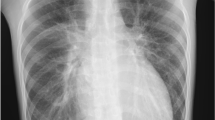Abstract
Heparin resistance (HR) is defined as increasing requirements of heparin to maintain a therapeutic activated partial thromboplastin time (aPTT). It is commonly associated with antithrombin deficiency, increased heparin clearance and elevations in heparin binding proteins. Elevated factor VIII levels can cause decrease the aPTT levels (anticoagulant effect) without disturbing heparin activity measured by anti-Xa assay (antithrombotic effect) leading to an apparent heparin resistant state rather than a true heparin resistance. We highlight the importance of increasing awareness of apparent HR and early distinction from true resistance to avoid major life threatening hemorrhagic complications. We hereby report an unusual case of heparin resistance due to increased factor VIII levels in an elderly male with infective endocarditis.
Similar content being viewed by others
References
Levine MN, Hirsh J, Gent M et al (1994) A randomized trial comparing activated thromboplastin time with heparin assay in patients with acute venous thromboembolism requiring large daily doses of heparin. Arch Intern Med 154:49–56
Uprichard J, Manning RA, Laffan MA (2010) Monitoring heparin anticoagulation in the acute phase response. Br J Haematol 149:613
Chiu HM, Hirsh J, Yung WL et al (1977) Relationship between the anticoagulant and antithrombotic effects of heparin in experimental venous thrombosis. Blood 49:171–184
Cloyd GM, D’Ambra MN, Akins CW (1987) Diminished anticoagulant response to heparin in patients undergoing coronary artery bypass grafting. J Thorac Cardiovasc Surg 94:535–538
Staples MH, Dunton RF, Karlson KJ, Leonardi HK, Berger RL (1994) Heparin resistance after preoperative heparin therapy or intraaortic balloon pumping. Ann Thorac Surg 57:1211–1216
Whitfield LR, Lele AS, Levy G (1983) Effect of pregnancy on the relationship between concentration and anticoagulant action of heparin. Clin Pharmacol Ther 34:23–28
Young E, Prins M, Levine MN, Hirsh J (1992) Heparin binding to plasma proteins, an important mechanism for heparin resistance. Thromb Haemostas 67:639–643
Edson JR, Krivit W, White JG (1967) Kaolin partial thromboplastin time: high levels of procoagulants producing short clotting times or masking deficiencies of other procoagulants or low concen-trations of anticoagulants. J Lab Clin Med 70:463–470
Becker RC, Corrao JM, Bovill EG, Gore JM, Baker SP, Miller ML et al (1990) Intravenous nitroglycerin-induced heparin resistance: a qualitative antithrombin III abnormality. Am Heart J 119:1254–1261
Royston D (1992) High-dose aprotinin therapy: a review of the first five years’ experience. J Cardiothorac Vasc Anaesth 6:76–100
Cirisano FD, Lee S, Greenspoon JS (1996) Apparent heparin resistance form elevated factor VIII in a patient with postoperative deep venous thrombosis. A case report J Reprod Med 41(3):191–194
Esposito RA, Culliford AT, Colvin SB, Thomas SJ, Lackner H, Spencer FC (1983) Heparin resistance during cardiopulmonary bypass: the role of heparin pretreatment. J Thorac Cardiovasc Surg 85:346–353
Raschke RA, Guidry JR, Foley MR (2000) Apparent heparin resistance from elevated factor VIII during pregnancy. Obstet Gynecol 96:804–806
Spiess BD (2008) Treating heparin resistance with antithrombin or fresh frozen plasma. Ann Thorac Surg 85:2153–2160
Ranucci Marco, IsgroÁ Giuseppe, Cazzaniga Anna, Ditta Antonio, Boncilli Alessandra, Cotza Mauro, Carboni Giovanni, Brozzi Simonetta (2002) Different patterns of heparin resistance: therapeutic implications. Perfusion 17:199–204
Olson JD, Arkin CF, Brandt JT, Cunningham MT, Giles A, Koepke JA, Witte DL (1998) College of American pathologists conference XXXI on laboratory monitoring of anticoagulant therapy, laboratory monitoring of unfractionated heparin therapy. Arch Pathol Lab Med 122:282–298
Guervil DJ, Rosenberg AF, Winterstein AG, Harris NS, Johns TE, Zumberg MS (2011) Activated partial thromboplastin time versus antifactor Xa heparin assay in monitoring unfractionated heparin by continuous intravenous infusion. Ann Pharmacother 45(7–8):861–868
Author information
Authors and Affiliations
Corresponding author
Rights and permissions
About this article
Cite this article
Thota, R., Ganti, A.K. & Subbiah, S. Apparent heparin resistance in a patient with infective endocarditis secondary to elevated factor VIII levels. J Thromb Thrombolysis 34, 132–134 (2012). https://doi.org/10.1007/s11239-012-0692-z
Published:
Issue Date:
DOI: https://doi.org/10.1007/s11239-012-0692-z




